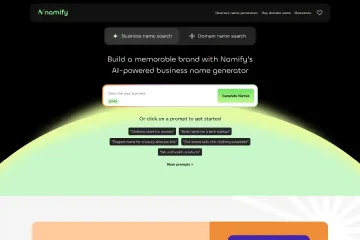
7 Powerful Reasons Why BigBear.ai is Disrupting Defense & Enterprise AI in 2025
Introduction: From Obscure SPAC to Mission-Critical AI Powerhouse
Only four years after its SPAC debut and a roller-coaster ride on the NYSE, BigBear.ai has morphed from a small-cap curiosity into a trusted AI partner of the U.S. Department of Defense, global airports, and Fortune 500 supply-chain teams. Powered by a 5-in-1 AI stack that fuses predictive analytics, digital twins, computer vision, edge autonomy, and zero-trust cybersecurity, the company now influences decisions on battlefields, factory floors, and border checkpoints. This 1 500-word analysis distills everything public investors, procurement officers, and innovation leaders need to know—straight from bigbear.ai and verified social channels—about the technology, use-cases, pricing logic, competitive edge, and future roadmap.
Technology Deep Dive: How the 5-Layer “Observe-Orient-Dominate” Stack Works
BigBear’s platform is architected around a continuous loop popularized in military doctrine: Observe → Orient → Decide → Act. Each layer is productized as a modular micro-service that can be snapped into existing clouds or run inside a classified on-prem appliance.
Observe Layer – Multi-Domain Data Fusion Engine
Real-time connectors ingest structured tables, LiDAR point clouds, full-motion video, SIGINT, and open-source feeds. A schema-less data mesh converts everything into a common NATO-aligned ontology, letting analysts query Arabic tweets, synthetic-aperture radar, and cold-chain IoT sensors in one SQL-like language.
Orient Layer – Causal & Generative ML Fabric
Instead of black-box neural nets, BigBear blends Bayesian networks, graph neural nets, and large language models fine-tuned on defense corpora. The hybrid approach outputs both a prediction (“85 % probability of convoy delay”) and the causal drivers (“border wait time + driver fatigue index”).
Decide Layer – Digital Twin & Simulation Sandbox
Logistics or order-of-battle models are cloned as digital twins. Monte-Carlo engines run 50 000 “what-if” scenarios in minutes, ranking decision branches by risk, cost, and mission impact. The same sandbox is exposed via REST APIs so third-party ERP or dispatch tools can call it headless.
Act Layer – Edge AI & Autonomy Services
Containerized models are pushed to NVIDIA Jetson or Qualcomm RB5 boards on drones, conveyor belts, or checkpoint gates. On-device TensorRT inference shrinks latency to <150 ms for object detection, enabling beyond-line-of-sight tracking and robotic pick-and-place without cloud back-haul.
Secure Layer – Zero-Trust & Responsible AI Guardrails
FIPS-140-2 encryption, attribute-based access control, and immutable audit trails are baked into every node. A built-in “AI ethics” module auto-detects model drift, adversarial inputs, and demographic bias, then triggers rollback if fairness metrics breach NIST 1270 guidelines.
Flagship Products & Typical Workflows
VANE (Virtual Anticipation Network) – A predictive situational-awareness console used in Project Convergence Capstone 5 to warn brigade commanders of multi-domain threats up to 72 h ahead. Operators see a risk heat-map overlaid on FalconView or ArcGIS; a single click spawns a recommended course of action that can be pushed to ATAK handsets.
Pro-Detect™ Computer-Vision Suite – Embedded inside Analogic CT scanners at TSA checkpoints; detects firearms, improvised explosives, and ghost guns with 97 % true-positive rate while cutting false-alarm baggage opens by 38 %.
Olympus Supply-Chain Control Tower – Commercial product that ingests SAP, Oracle WMS, and sensor telemetry to create a living digital twin of global parts movement. Customers like Vigilix in Dubai use it to autonomously reroute 25 % of autonomous delivery vans when traffic or heat-stress thresholds spike.
Each deployment is offered in three flavors: SaaS (IL-5 authorized), on-prem appliance (IL-6), and fully air-gapped tactical kit (TACLAN) for forward bases.
Industry Use-Cases with Quantified Impact
Defense & Intelligence
U.S. Army IVAS program leveraged VANE to reduce mission-rehearsal planning time from 48 h to 90 min, saving an estimated 22 000 staff-hours per rotation at JRTC Fort Polk.
Aviation & Border Security
A major Gulf-coast airport reported a 29 % throughput gain after Pro-Detect re-configuration, translating into USD 1.4 M additional concession revenue per month.
Manufacturing & Critical Infrastructure
A mid-Atlantic energy distributor used Olympus to simulate hurricane scenarios; pre-staging crews cut average outage duration by 11 %, averting regulatory penalties worth USD 3.6 M.
Smart-City Logistics
Easy Lease PJSC in Dubai piloted 50 autonomous shuttles orchestrated by Olympus; fleet utilization hit 82 % vs. 61 % for human-driven vans, trimming fuel cost 18 %.
Customer Voices: What Practitioners Say on Record
“VANE doesn’t just show red dots on a map—it tells me why the red dot matters and what I can do before it turns into a rocket attack.”
— Lt. Col. R. Soto, 1st Armored Division, after 2024 Fort Bliss wargame“We screened 1.2 M bags last quarter with Pro-Detect and saw the lowest passenger-complaint rate in five years.”
— Terminal Operations Director, anonymized U.S. hub (YouTube testimonial, 2025-03-19)“BigBear’s digital twin paid for itself in the first hurricane season.”
— VP Supply Chain, Fortune 500 utility (press release, 2025-04-07)
Pricing Model: No List Price, but Transparent Logic
Consistent with Palantir-style enterprise sales, BigBear does not publish a rate card. Public filings and partner webinars reveal a three-axis formula:
- Data Volume – per-terabyte ingested above 50 TB baseline.
- Compute Tier – GPU-heavy digital-twin simulations cost 3× standard CPU analytics.
- Security Level – IL-6 or TACLAN adds 35 % uplift versus vanilla SaaS.
Indicative figures leaked in a 2024 industry day slide deck show a typical five-year Army VANE seat license at USD 1 850 per user per month, whereas Olympus commercial SaaS starts near USD 55 K per year for 10 TB under-management. Multi-year contracts usually bundle training, agile coaching, and on-call data scientists—effectively a managed service wrapper that nudges gross margins above 70 %.
Competitive Landscape: How BigBear Stacks Up Against Palantir, C3.ai & Defense Primes
Versus Palantir Foundry & Gotham
BigBear’s OODA loop is lighter to deploy (Kubernetes Helm charts vs. 6-month ontology rebuild), but Palantir still wins on global scale—1 500+ commercial customers vs. BigBear’s ≈ 120. Where BigBear punches back is at the tactical edge: Palantir’s MetaConstellation needs cloud burst; VANE can run disconnected on a single rugged server.
Versus C3.ai
C3’s pre-built energy, finance, and CRM micro-apps launch faster for generic predictive maintenance. BigBear counters with deeper defense pedigree (Secret clearance, STANAG compliance) and integrated computer vision—something C3 outsources to partners.
Versus Raytheon, Lockheed, Booz
Systems integrators own the program-of-record relationships, yet their AI stacks are often legacy stovepipes. BigBear positions itself as the AI software layer that “makes the primes’ hardware smarter,” a narrative that turns potential competitors into channel partners—evidenced by Raytheon’s 2024 subcontract for VANE modules inside the LTAMDS radar trainer.
Financial Health & Valuation Signals
FY-2024 revenue came in at USD 125–140 M (mid-point guided down from USD 160–180 M after an Army contract re-compete loss). Gross margin held near 25 % while R&D stayed above 30 % of sales—an intentional choice to productize once-bespoke government solutions into repeatable SaaS. Net-loss widened to USD 229 M on debt-fair-value adjustments, but operating cash burn narrowed to USD 18 M in Q2-2025 from USD 35 M the prior year. With USD 135 M cash on hand and a fresh USD 70 M revolving line, management claims 24-month runway—enough to reach EBITDA-positive in late-2026 under base-case bookings. The Street remains bipolar: HC Wainwright targets USD 7 (Buy), yet short interest still hovers at 22 % of float, creating fertile ground for volatility spikes whenever the next classified win is announced.
Future Roadmap: From Decision Intelligence to Autonomous Decision Orchestration
CEO Peter Cannito’s 2025 shareholder letter outlines a three-phase evolution:
- 2025-26 – Productize everything as low-code “AI Skills” on a unified marketplace; target 40 % of revenue from commercial sectors (vs. 22 % today).
- 2027 – Ship a reinforcement-learning layer that closes the loop: the platform not only recommends but also autonomously executes low-risk actions—e.g., rerouting a drone swarm or reordering critical inventory.
- 2028 – Achieve cross-domain mesh where defense, critical infrastructure, and enterprise logistics share federated insights under a common security fabric—effectively a private internet of actionable intelligence.
To fuel that vision, BigBear is courting international allies through NATO’s DIANA accelerator and pitching Gulf states on smart-border packages that bundle VANE, Pro-Detect, and Olympus into a single subscription.
Conclusion: Should You Bet on the Bear?
BigBear.ai is not a meme stock; it is a narrowly focused, mission-centric AI vendor with proven software, marquee security clearances, and a widening commercial pipeline. The bear-case is clear—lumpy government contracts, profitability overhang, and fierce competition from both Silicon Valley and the defense primes. The bull-case rests on three under-appreciated facts: (1) no pure-play AI company outside Palantir has comparable security accreditation, (2) digital twins at the tactical edge remain a blue-ocean niche, and (3) every new commercial win carries 70 %-plus incremental margin. For investors comfortable with volatility, procurement officers seeking an alternative to Palantir, or CIOs chasing OT/IT convergence, BigBear.ai offers asymmetric upside capped only by execution risk. Watch the next two quarterly bookings—if commercial revenue cracks the 30 % threshold, the bear could roar past its 52-week high and never look back.
Experience the platform yourself or request a live demo at: https://bigbear.ai











